2031 Timewaves
.png)
2031 Timewaves: sedimental analysis of microsites in the aftermath of the volatile waves
| Tara S. Regmi
This article is based upon a report submitted to the Department of Geological Survey (Kathmandu, Nepal) and Museum of Rocks and Minerals (Pokhara, Nepal). It is derived from the study of over 100 pieces of sediments, 10 of which are documented and presented here to support the findings.
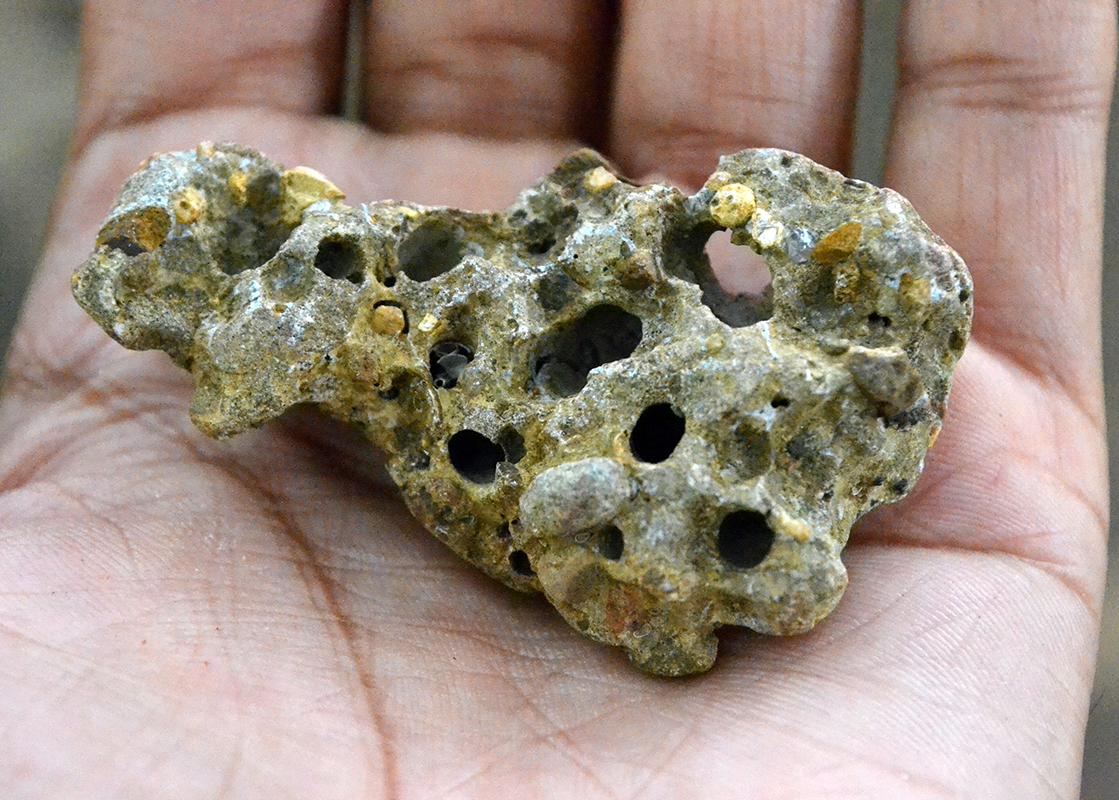
Sediment item 32.1: Perforated stone from a boundary wall of a newly constructed house. The wall was constructed four months before the impact; the stones started developing holes during a 28-32x Timewave that affected only this house while the neighboring houses stood unchanged.

Sediment item 32.2 (a,b- from left): A broken lamp from a temple during a rapid Timewave, the heat caused it to crack since it was within a high intensity impact site of less than 10 sq. ft. The incident led to a stampede when thousands of worshippers flocked to the temple the next day, calling it a miracle. Some worshippers called it God’s fury for the ‘human immodesty and blasphemy committed in the pursuit of science in the past decade that has lead to many temples facing heavy losses and closure due to an erosion in belief and further eroding footfall’.

Sediment item 32.3, 32.4, 32.5 (from left): Bones collected from a cremation site by the Bagmati river during a slow wave. The remains show peculiar coral formations as they decomposed simultaneously while interacting with the low intensity fire burning in the slow wave of approximately 0.021-0.03x.
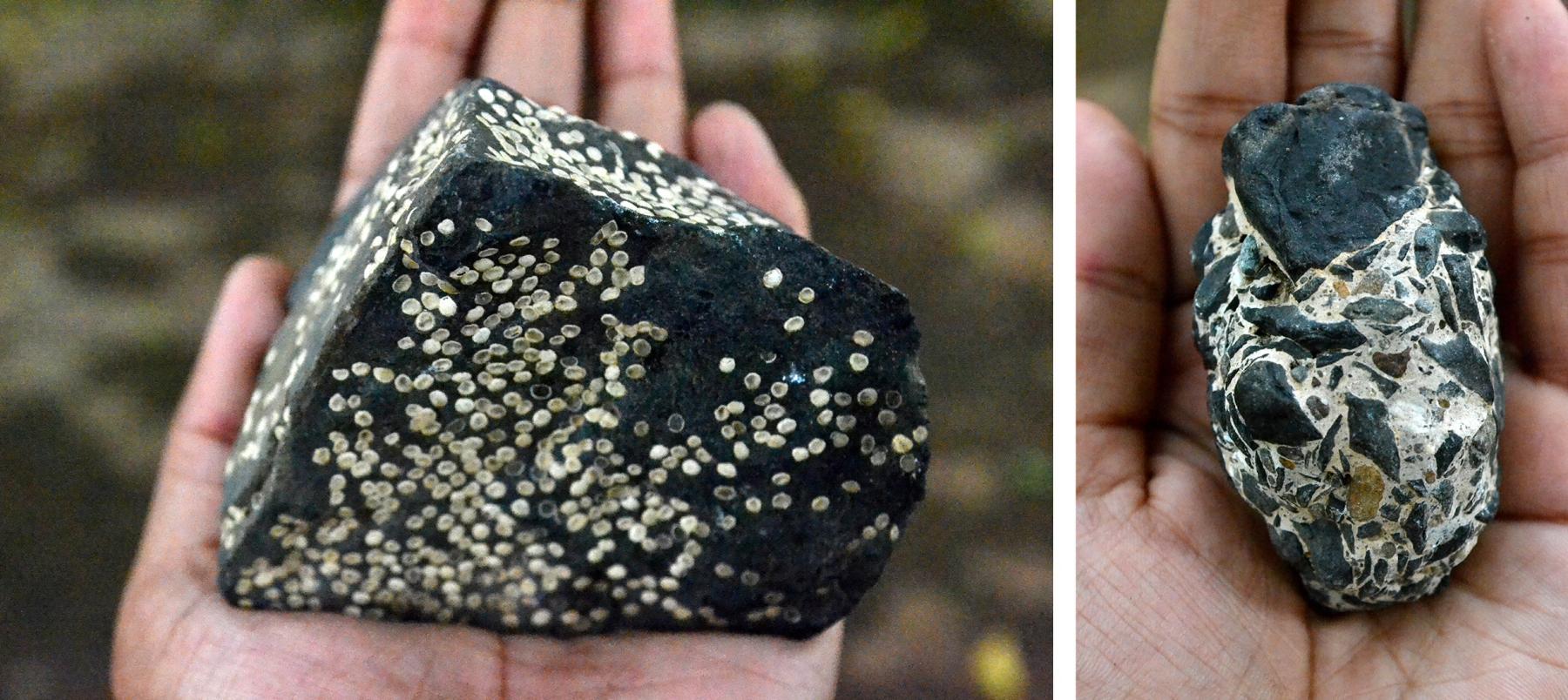
Sediment item 32.6, 32.7 (from left): Stones from the pavement of a road showing unusual growth of foreign organisms as round swollen warm bumps, slowly breathing in and out (32.6) and a slimy, sticky paste that has collected on small stones hence making them grow in size (32.7). It is difficult to identify what pace/s of the wave has caused them.
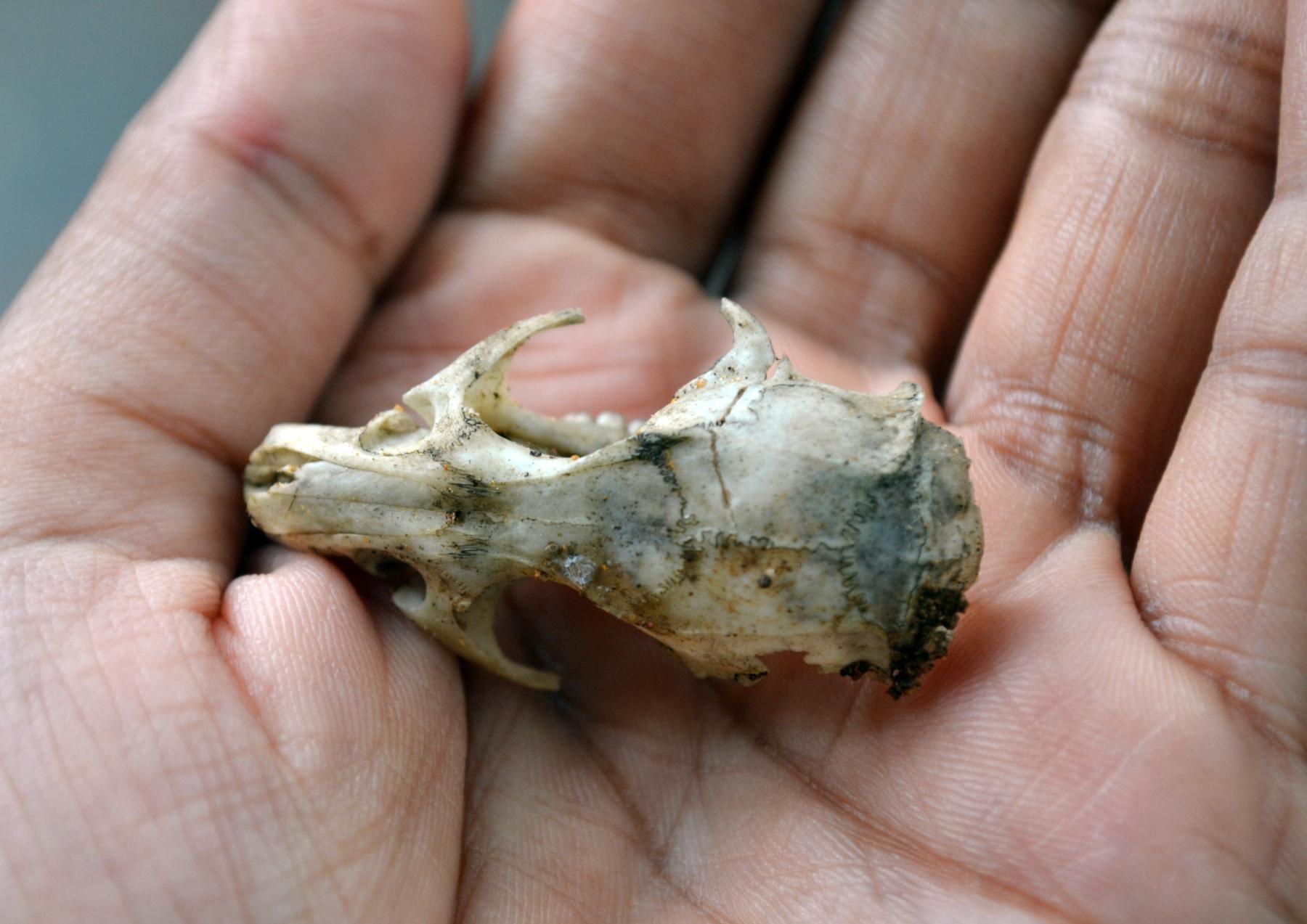
Sediment item 32.8: Rapidly decomposing skull of a rat found in a rat trap at a house, this is the smallest microsite recorded till now. The process took place within an hour of its death and shocked the two brothers, in their early teens, who caught and poisoned it to post a video on their new Viddist Kids channel.
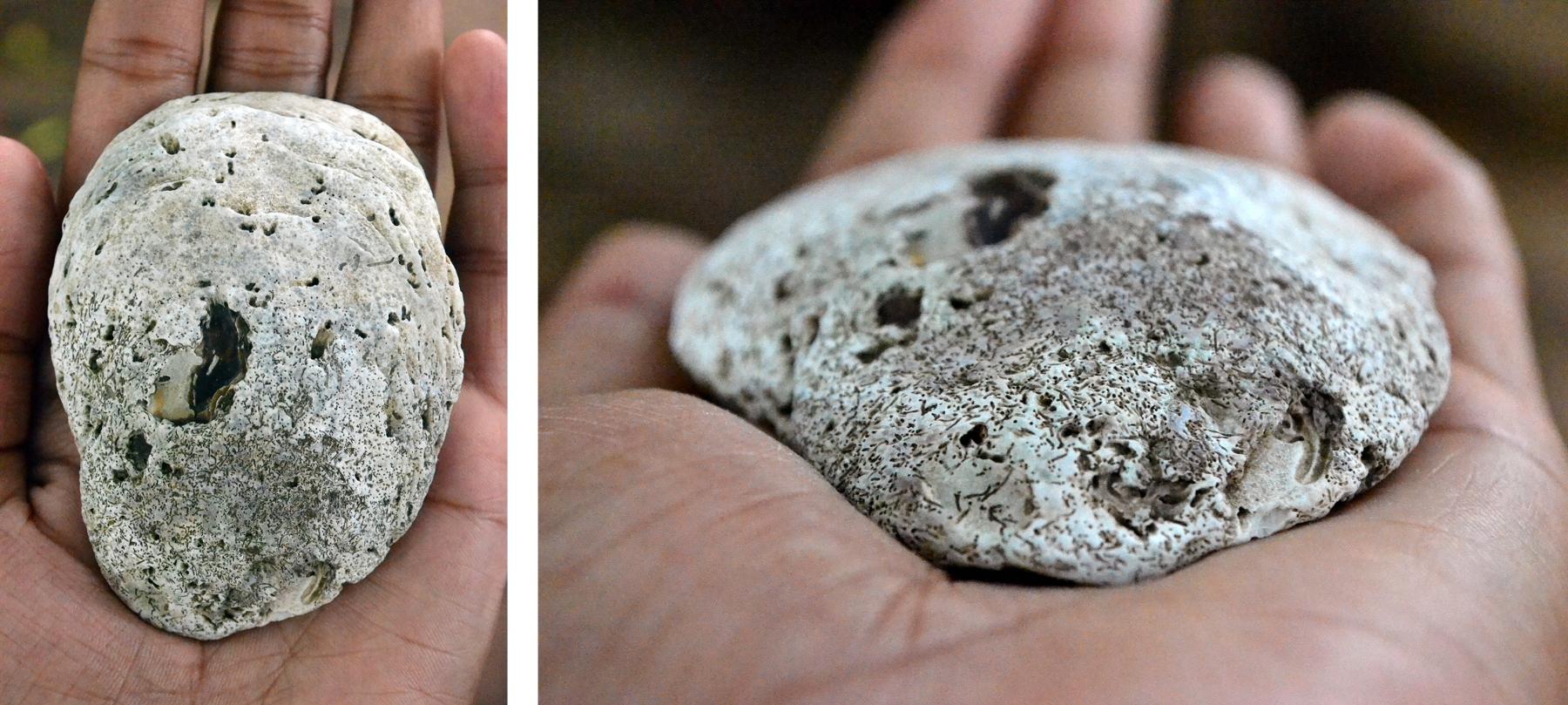
Sediment item 32.9 (a,b- from left): A 19th c. ivory sculpture of an intricately carved shell from the antiques collection of Shri Bikash Gurung. The carvings are erased and replaced by strange corrosive and porous markings that look like an infestation by some kind of small flocculent insects or parasites that have burrowed and merged with the material itself during a rapidly fluctuating wave. (32.9b- detail)
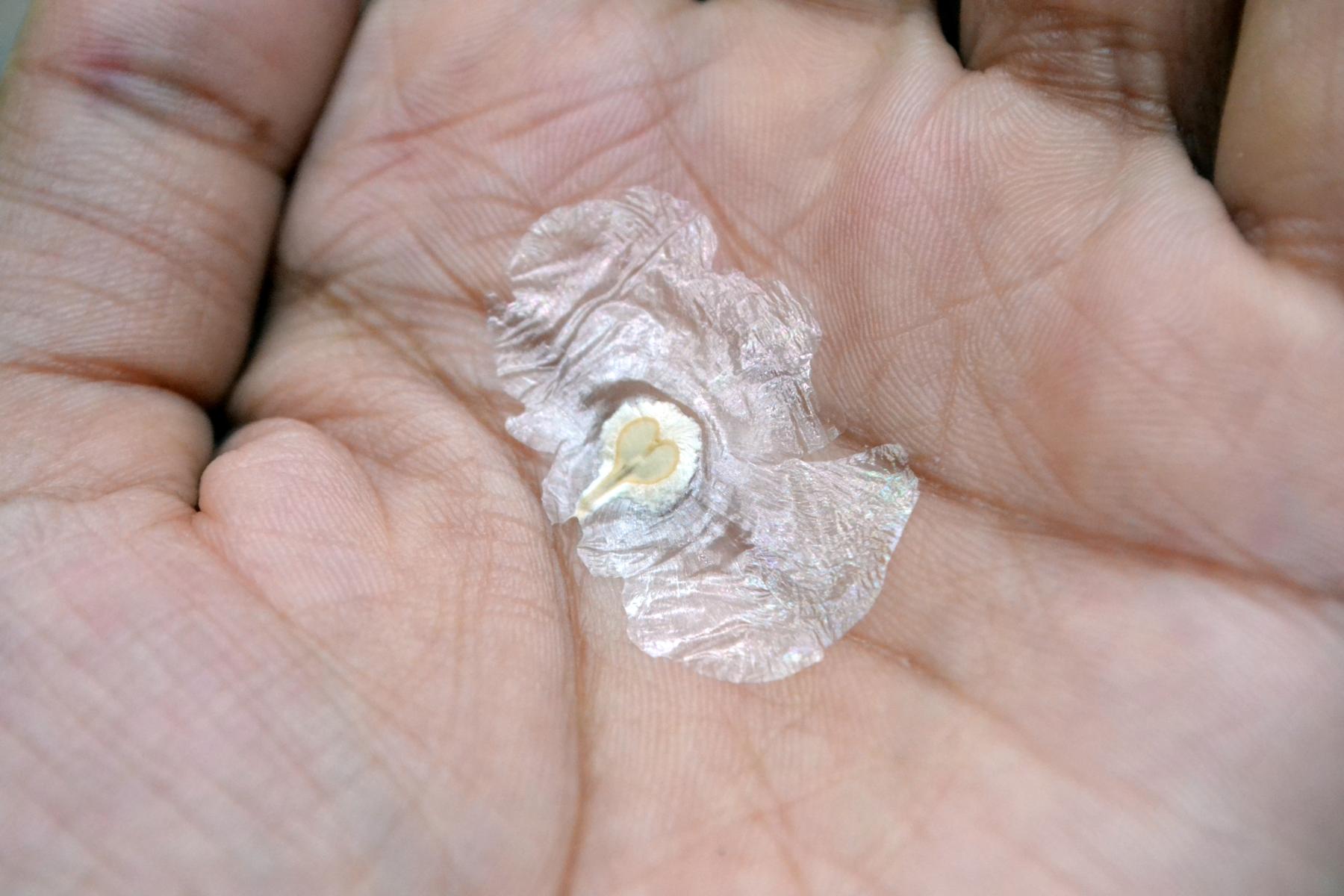
Sediment item 32.10: One of the thousands of Tickleweed seeds flying over a farm caught mid-air by children playing around in a slow wave; the seeds were floating slowly like a lost ship wandering in the open sea, untethered.
Background
In 2031 the Department of Geological Survey or DOGS (estd. 1953), an organization for geological research and protection, set up primarily to find coal deposits for the Railways, had to undergo a massive change from its main functions—the creation and maintenance of national geoscientific information and mineral resource assessment. After the 2031 Nepal Timewaves that struck from 2 March to 18 May, the Department got involved in finding and analyzing the impact sites in an effort to understand effects and patterns of temporal interaction on non-living matter. Under this initiative, in January 2032 the government of Nepal allotted a considerable section of the Museum of Rocks and Minerals to display the specimens that could be revealed to the public on a special entry ticket. The section was called 2031 समय लहरहरू ग्याले री or 2031 Timewaves Gallery: Specimens and Findings section. I was an intern there from February to August 2032 and findings from my initial report submitted to DOGS have been allowed to be published here abiding by the Terms of Public Data and its Circulation, subsection: Timewaves, pp. 221-250.
Introduction: Speculations
Timewaves – The first reports, coming as early as 15 December 2030 from various parts of Nepal, were dismissed as fake news by international media, the headlines were bordering on a derogatory and sarcastic edge: ‘Decades of developing countries, only in the wrong direction?’; ‘How religion and myth continues to overshadow our reason’; ‘Mis-altering with Time’ and others. However, when further reports surfaced from Central Europe and parts neighboring E-Ukrus, an emergency meeting was called upon between heads of affected nations and a delegate of astronomers, physicists and horologists from the impacted sites, to understand and assess the situation and find ways to contain its spread.
Originally defined by astronomers as ‘rare and minimal alterations in the speed of Earth’s rotation on its axis and revolution in orbit around the Sun’[1], the varying speeds lead to what was then understood as time warps, like ‘a wind or a wave sweeping through all that perceives and is perceived’[2], one of them wrote. However, this theory lacked any explanation for the anomalies between some places not experiencing any change while others suffering varying waves at an exponential scale, and thus was rejected by the British Organisation of Physics[3][4], followed by others.
From what we have understood till now, in strictly non-scientific terms, a Timewave is a disturbance in the speed of time-duration over an area ranging from a continent to a car, behaving like sea-waves, at times speeding (rapid-waves // timefloods) while other times slowing down (slow-waves // timeslugs/sloths). In rare occasions, the waves fluctuate between both speeds in the same region causing a time-lock[5], while sometimes as they recede they cause reversal of time[6]. A large part of the ongoing study on Timewaves and its volatile behavior and impact remains inconclusive; it is either filled with self-contradictory problems or is misunderstood due to lack of sufficient progress and a ‘rapid-wave’ of misinformation.
Nonetheless, the imagination of such a phenomenon is bereft of any probabilities or logic demonstrated by anyone in recorded history who has tried to unravel the physical laws that govern the universe.
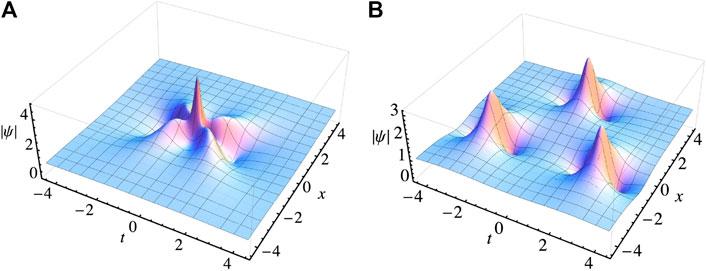
Fig. 1, 2: Timewave behaviour: A scattered Rogue wave with crest-trough densities at parameters γ=200 γ=200 and β=0β=0[7].
It is, however, believed that the effect of a Timewave only impacts the artificial/ material time of bodies and objects; it has no effect on the conscious/ lived time of the mind and perception considering that, although being swept by the waves, we can distinguish between their speed and observe the impressions on our bodies and other material world—until now there has been no evidence to think otherwise[8]. Even animals can sense the fluctuations by showing significant behavioral signs of shock, dismay and fear, now referred to as Timewave-Induced Shock Syndrome[9] seen in different animals exhibiting in their own peculiar ways: house lizards go into unseasonal brumation, while humans are most susceptible and are seen to be hoarding and fleeing at the first cue.
Occurrences and observations
The initial waves came as a mild warning for what would transform our understanding of time, altering its very fabric. The Physical Research Lab at Kathmandu University calculated the wave to be at the speed of 0.88x, extending the number of hours in a day to 27.27 hours, and further slowing down as it progressed towards and hit the last tidal-axis or its shores. A local news channel, with confidential sources at the lab, leaked multiple videos in vain attempts to warn the habitants, this is one of the videos of a tardigrade moving—the cause for the lag in sound reception in the recording device during slow-waves remains unexplained. This was also the year when the sonic microscopes were being employed for the first time, capturing the minute sounds of various micro-animals and organisms.
The first significant wave’s tidal-axis mapped from the east of Jardeu Bromo to north of Dumja - Timewaves are not centrifugal like earthquakes but like sea tides - ascending towards Kodari to Jiri and impacting the farthest point with exceeding intensities i.e. slowness. The time on tidal-shores was calculated at 0.65x prolonging a day to 36.92 hours and the wave was felt in different parts of its axis at varying rates. It was cresting and troughing inconsistently between 0.88x to 0.65x the original pre- timewave (PT) speed.

Fig. 3: Geospatial mapping to show movement of the first recorded Slow Timewave on its axis. Nepal, 2031.
Such slowness was still plausible within the perceptible paradigms of the human mind; some say they started long before but couldn’t be sensed, either due to low-impact, momentariness or covering a very short axis targeting ‘microsites’. The slow wave receded after 3 months of its origin but within a week it relapsed with multiplied rapidity along a tilted axis at a speed ranging from 1.09x to 2.2x PT (all this data is relative to the standard time of a non-affected region closest to the axis). In no time, a large part of the occupied world succumbed to this speeding wave whose tidal-axis started from Norway- shoring towards south of Beaufort sea to Northwest of Chile.
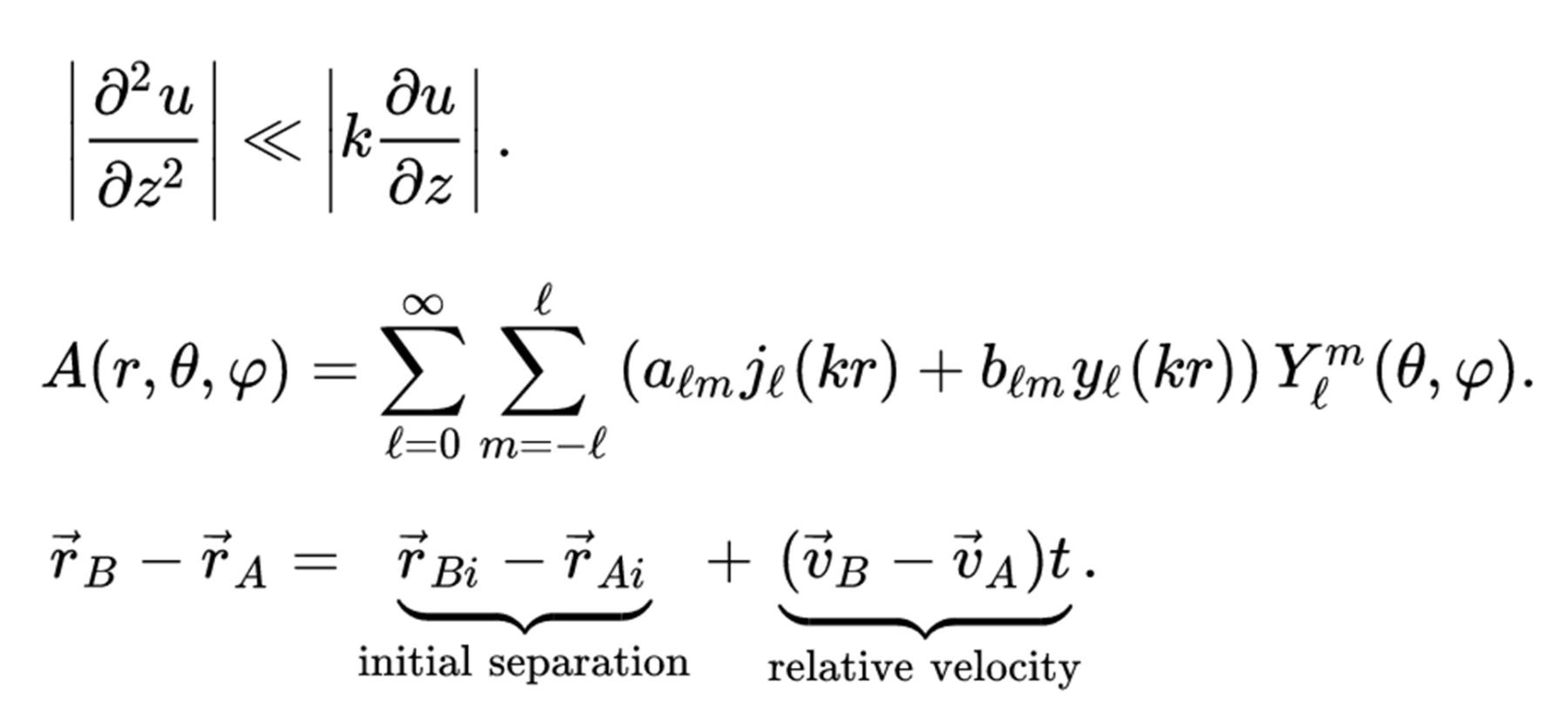
Fig. 4, 5, 6: Calculations to theoretically predict the movement of Timewaves, where u and A are the slowly varying functions of z and r. The difference between the two displacement vectors, {{r}}_{B}-{ {r}}_{A}}, represents the location of B as seen from A. | Dan-Cristian Schmelcher from the Niels Bohr Institute, University of Copenhagen.
Studying Microsites and the Sediments
The impact sites include not only large areas, but some Timewaves hit surgically affecting only a house, at times targeting an area as small as a room or a chair, making them difficult to locate[10]. They leave sediments (specimens)—material showing unusual temporal qualities being affected by the wavering tides. As they recede, we can feel a recession in time; I’ve managed to assemble a collection of such sediments from these rare reversing or fluctuating waves, like this sound recording with the speech in reverse, and a clock that struggled between two opposing Timewaves.
Due to their insignificance, microsites have remained underreported and ignored by mainstream media and central agencies assigned to research the impact of Timewaves around the world. Through this essay and the research on the collected sediments, I have attempted to bring forth new findings anchored around the impact on microsites that has been acute and as my findings show– the intensity and impact of a Timewave is inversely proportional to the size of the site. Here is the data sheet for the 10 sediments from these sites whose corresponding photographs you see at the beginning of the essay. I have collected them on my field walks to reported sites in Kathmandu and the surrounding areas over the months of my internship (the photographs are taken with hand to show their scale).
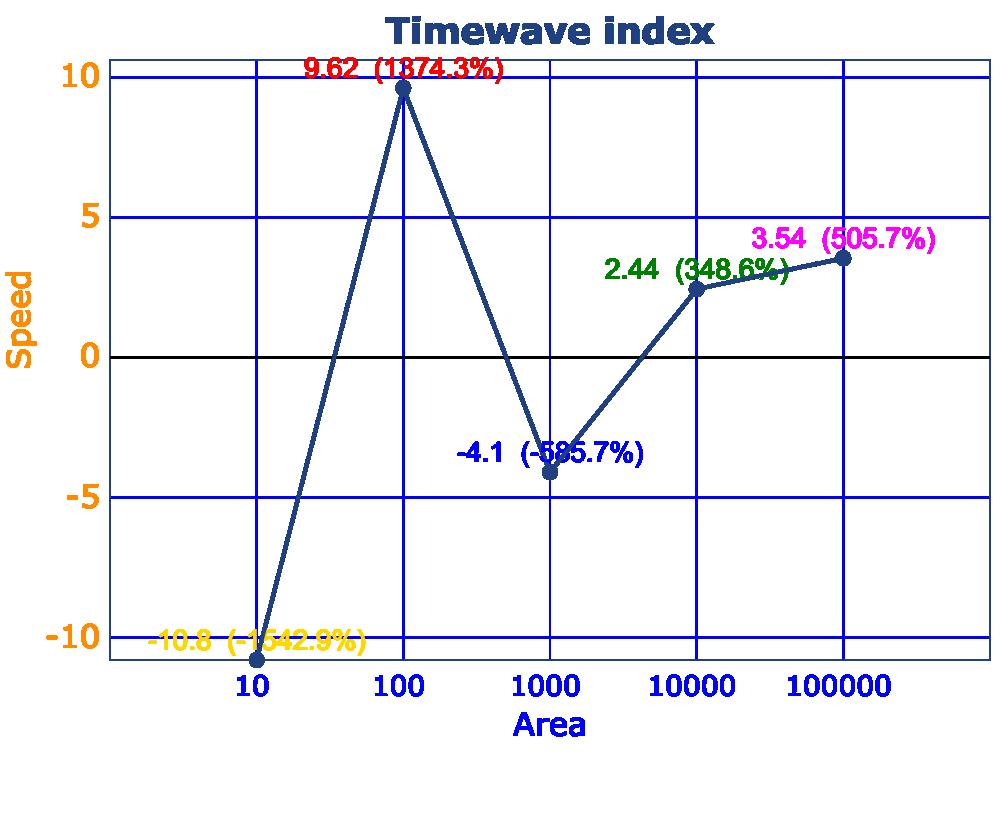
Fig. 7: Microsite Impact Index: area x velocity
Location: Kathmandu to Motihari
Between May 2031 to September 2032
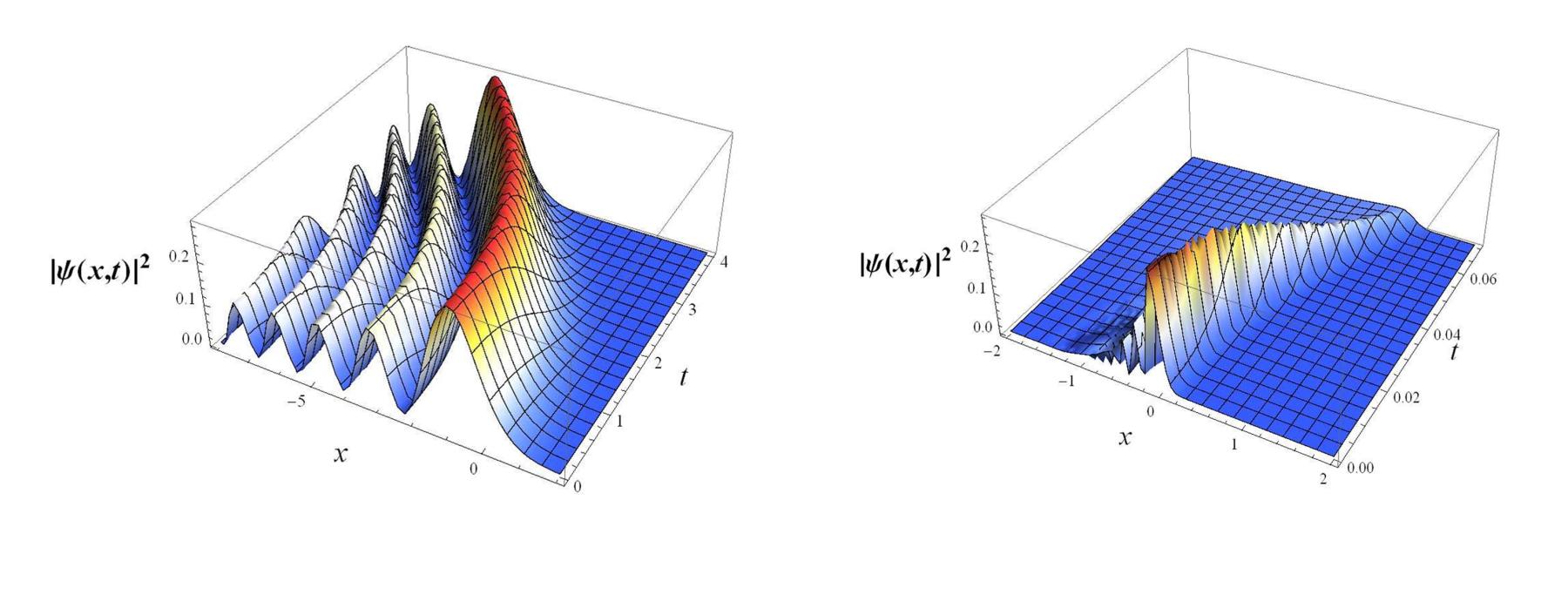
Fig. 8, 9: Predictive visualizations [8] Fluctuating waves- movement over a microsite through x area causing space curvatures in inverted velocities. [9] Rapid wave movement over a microsite causing an acute fold in time fabric.
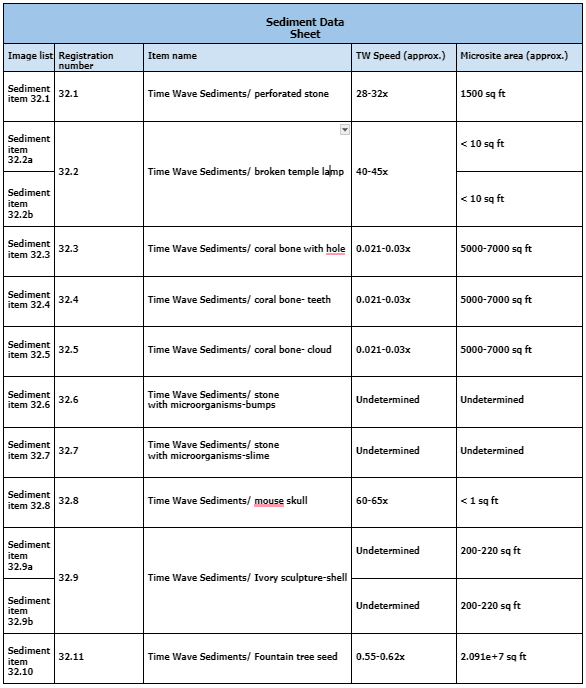
References:
1. la Fournier, T. Y. V. ed. (2031)
“The Rubicon of Time identity: the matrices of Earth's movements." Journal of Astronomical Studies, vol. 42, no. 3, 2031, pp. 123-136.
2. Oh, Jane. "Time warps" Proceedings of the International Astronomical Symposium, vol. 17, 2032, pp. 45-58.
3. Von Ludwig Z., Emily S. "Anomalies in the theory of time warps." British Organisation of Physics Conference Proceedings, vol. 78, 2031, pp. 234-248.
4. British Organisation of Physics. (2032). "Rejection of the Time Warp Theory." Annual Report on Astrophysical Research, 2031, 102-105.
5. Sunita, L. (2031). "Observations on Timelocks and their Impact on Time Perception and Human Psychology." Journal of Temporal Psychology Studies, 16(1), 34-49.
6. Satyajit, S. (2031). "Timewaves: A Non-Scientific Interpretation." Journal of Speculative Studies, 8(4), 567-581.
7. Akhmadiev, L. "Waves that Appear From Nowhere: Complex Rogue Wave Structures and Their Elementary Particles." Research Thesis, Department of Theoretical Physics, Research School of Physics, The Australian National University, 2032, pp. 89-102.
8. Grothendieck, David. "Predicting Timewaves: revisiting the Einstein-Bergsonian debate." Journal of Temporal Phenomena, vol. 12, no. 4, pp. 321-335.
9. Carter, J. (2032). "Timewave-Induced Shock Syndrome (TISS): Instinctual and Behavioral Indications in Animals and Insects." Journal of Behavioral Sciences, 21(3), 412-425.
10. Johnson, Kristine. "Uncovering Hidden Timewave Impacts: Microsite Phenomena and Sediment Collection." Fictional Distortions Press, no. 2: 75-88.

Author’s Note: 2031 Timewaves is a fictional premise, contrived in the format of an article-cum-report published by a young geologist who, having interned at the Department of Geological Survey (DOGS) in Nepal, sets out in the pursuit of studying and uncovering the truth behind ‘microsites’ through samples (sediments) collected by her. As the reader looks at the photographs and reads through the captions and her semi-objective account of the incidents, the narrative unfolds into what occurred in 2031 and continues as she writes. She builds up on detailed metaphors, absurd anecdotes and scientific speculations to support her account of a sudden and strange temporal calamity, while zooming out into a world of numbers, maps and graphs strengthening the veracity of the narrative. The report looks back at a current event that is unfolding in real time while being located in our real-time’s future, not-so-far, not-so- unbelievable—a foreseeable and plausible reality.
All the characters, places, calculations, graphs and reference-list are fictional or fictionally placed to secure the story.
Image credits (non-fictional):
Sediment Item (32.1-32.10) – photographs taken by Sonam Chaturvedi, Bhubaneswar, 2017.
Figure 1, 2 – Screenshot, Akhmediev N (2021) Waves that Appear From Nowhere: Complex Rogue Wave Structures and Their Elementary Particles. Front. Phys. 8:612318. doi:10.3389/fphy.2020.612318
Figure 3 – Edited Google Maps image by Sonam Chaturvedi, 2023.
Figure 4, 5 – Wikipedia contributors, "Helmholtz equation," Wikipedia, The Free
Encyclopedia, https://en.wikipedia.org/w/index.php?title=Helmholtz_equation&oldid=1157450262 (accessed June 28, 2023).
Figure 6 – Wikipedia contributors, "Relative velocity," Wikipedia, The Free
Encyclopedia, https://en.wikipedia.org/w/index.php?title=Relative_velocity&oldid=1135400784 (accessed June 28, 2023).
Figure 7 – Graph created by Sonam Chaturvedi, 2023.
Figure 8, 9 – Screenshot, Soto-Eguibar, Francisco, and He ́ctor M. Moya-Cessa. “Some Particular Initial Conditions.” Solution of the Schrodinger Equation for a Linear Potential Using the Extended Baker-Campbell-Hausdorff Formula, Applied Mathematics & Information Sciences, an international journal, Vol.9, 2015, p. 178, https://www.naturalspublishing.com/Article.asp?ArtcID=7433.
Sonam Chaturvedi is a multi-form artist and educator based in Delhi with BFA from Faculty of Fine Arts, M.S. University, Baroda and MFA from Shiv Nadar University, Greater Noida. Through her practice she tinkers around and subverts the experiences of time and durationality within the present technocapitalist structures of continuities, connectivities and consumption through speculative fiction, inter-media installations, artist book, sound, video, automated-calling system, multi-form lexicons and others. She has initiated –out-of-line–, pixel:dust and co-initiated first draft, as associative self-organised spaces for co-creation, gatherings and play. She is a visiting faculty at Shiv Nadar University, Greater Noida.




